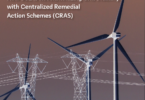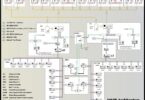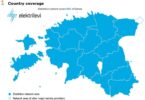By Jean Raymond, Hydro-Quebec, Canada
Context (The Whats and Whys)
Modern power grids are evolving into highly integrated networks of electricity generation, transmission, and distribution facilities together with DERs on customer premises—solar-generation, energy-storage, wind-power, and grid-interactive devices (home automation), for example. The energy transition is also driving rapid transformation, with technological advances, changing consumer preferences and new policies fostering DERs and forcing utilities to rethink how the grid works.
Several factors and sources of risk contribute to the new complexity of the electricity network, particularly:
- Variability and intermittency of renewable energy generation
- Decline in frequency response capacity and system inertia
- Load model modifications and unpredictability
- Faster and unanticipated system dynamics
- Need to manage a fast-growing number of generation and load variables
- Cyberattacks
- Climate change and power-grid exposure to extreme events
- Market volatility
- Disturbed supply chains for key grid assets
Providing customers with reliable electricity is nonetheless a necessity not an option: reliable electricity is an essential service. This is becoming more challenging for electric utilities, however, given the increase in the magnitude and frequency of sources of risk. (Figure 1).

The entire electrical network must deliver electricity and maintain service levels over long periods of time during which they undergo maintenance, upgrading and integration of complex new technologies and increased capacity while operating in a hostile environment. These circumstances entail deep uncertainties and emergent as well as systemic risks. Power grids should be considered complex systems composed of multiple interacting components/systems designed to provide optimal performance, safe, reliable operations and the flexibility and adaptability to respond to new contexts (technological, societal, economic, legislative, political, climate change, etc.) that define service demand and expected performance.
These conditions have prompted to consider the integration of other new concepts in our standards:
Dynamic system: Dynamic behavior and dependence are typical characteristics of modern systems. Specifically, system load, stress levels, redundancy levels, and other parameters of the operating environment may change over time, leading to dynamics in the failure behavior of components/systems and affecting their reliability requirements. Additionally, components/systems may have significant and changing dependencies or correlations over time. Modeling the effects of these dynamic and dependent behaviors is crucial for prediction, analysis of their reliability, as well as for other optimization activities (maintenance, design, etc.).
Component Behavior (nonlinearity):Nonlinearity behavior is a type of relationship that cannot be explained as a simple linear combination or sum of its variable inputs, but exhibits another relationship that could be logarithmic, exponential, or power. Nonlinear cause-effect relationships require complex modeling and predictions to explain certain events.
A nonlinear system can have more complex steady-state behavior than those usually listed such as equilibrium, periodic oscillations, etc. In this case, the output of the system is extremely sensitive to the initial conditions, hence the unpredictability of the output.
Human Factors: Technology is evolving at a very rapid pace, requiring continual changes to existing systems and even the organizational structures responsible for managing them. As a result, many designers and managers are faced with increasingly fundamental problems such as:
- How can the designs or operations result in human errors?
- How will humans be able to make real-time decisions in a deterministic/probabilistic and dynamic world, with unpredictability being governed by complex and uncertain behaviors?
- What are the potential consequences of these human behaviors?
- What barriers can prevent or mitigate the potentially negative consequences of these behaviors while not introducing new opportunities for human error?
- What are the impacts of staff shortages, retirements, and lack of expertise of new resources unfamiliar with the diversity of all automation systems?
Not considering human factors that influence our tasks, activities or technical developments amounts to depriving ourselves of information that could improve (often substantially) these tasks, activities, or developments. These questions fall directly into the complex issues of reliability and asset management.
Asset management and reliability: The technology-driven transformation, changing risk and regulation, and the integration of ESG (Environmental, Social, and Governance) criteria are impacting asset management processes. As a result, closer links between the concepts of human centricity, sustainability, and resilience must be established in the reliability and asset management frameworks. Technological evolution has shaped the history of industry and asset management.
The modernization of power plants and substations, the introduction of new technologies and coexistence with existing ones, as well as the challenges outlined above imply the components/systems of power plant and substation to become more reliable. However, reliability as we know and study it until now must take on a new dimension. The complexity of future components/systems, together with the omnipresence of software, leads us to consider topics that have never been included so far. The variability and unpredictability of supply and demand, the transition from a deterministic to a probabilistic behavioral world, the bidirectionality of energy flow and regional differences will, among other things, give rise to different power plant and substation that will constantly adapt in real-time to offer the best expected performances.
Different operational time ranges of the electricity network: The operational periods during which a variety of control methods are applied differ significantly (usec to days). The potential for DERs incorporation has introduced greater variability in net load and energy imported to the electricity grid (self-production). This results in a more dynamic operating environment resulting in decentralized control to the power plant and substation where autonomous actions are required.
As variability increases, various functions such as voltage management and protection must not only operate on faster time scales but be modified to accommodate the reverse flows of energy produced by DERs. In addition, these same functions must also integrate the management of power electronics. These requirements push the next generation of automation and control systems well beyond current capabilities, not to mention that existing ones will be affected by constraints requiring them differently.
As the amount of distributed generation continues to increase, the electricity grid becomes increasingly susceptible to disruptions. This means that the time window to respond to critical failures is shrinking all the time hence the need to introduce and use more intelligent automatic control techniques.
Possible multi-states of component: A system and its components have always been considered to have only two operating states: working perfectly or not working, resulting in complete failure. Although this assumption simplifies the complex problems of reliability assessment, it loses the ability to reflect the true reality that most components/systems degrade gradually and can exhibit a wide range of states in terms of function and performance. As a result, the degradation of components/systems results over time in different levels of functional performance. On the other hand, it is not realistic to assume that components/systems have the same number of states.
Degradation of component/system: The degradation mechanisms associated with a failure rate can lead to different levels of operational performance and therefore to a multi-state structure. Electrical and mechanical components/systems age in operation and their reliability decreases with operating time or their stress history. The latter could result from degradation due to the accumulation of damage or simply from the effect of multiple applications of stresses imposed randomly.
More complex stress and degradation conditions, a stronger dependence between different failure mechanisms and different components, and a more obvious decrease in reliability during operation also lead to an increase in complexity of components/systems.
That’s why now we must consider the overall grid as an Energy System. (Figure 2).

End-to-end Energy System Operation
- Fundamental requirements: To add to traditional main stability criteria (voltage, current, frequency, and their rate of change), described below are critical criteria required to cope with the changes of the energy transition and meet the expectations of tomorrow:
- Autonomy: Component/system collects information, processes data, and makes consequent decisions.
- Flexibility: New functions can be added at any time without modification thanks to standardized, interoperable foundations and advanced applications. Component/system also has the operational functionality to react to unpredictable variations in supply and demand and remain stable and reliable.
- Adaptability: Real-time adjustments can be made to automation system operating parameters (protection and other) based on conclusions of the data analysis (autonomy).
- Predictability: Probabilistic and dynamic rather than static aspects of solutions are fore fronted given the constant variability of the environment, with data analyzed in real-time to predict and simulate behavioral trends and anticipate failures.
- Resilience: Resilient power system can limit the extent, severity and duration of component/system degradation following a disruptive event by reacting in such a way as to maintain the component/system essential function, identity, and structure. This is achieved through a set of actions taken before, during and after extreme disruptive events that include anticipating, preparing, absorbing, maintaining critical system operations, rapid recovery, adaptation, and application of lessons learned. Depending on the type of event, the time axis could be in ms, seconds, minutes, hours, days and more.
Autonomous power plant and substation (Transport/Distribution): Adapting in real-time to different dynamic regional contexts while contributing to grid stability, future power plant and substation are operated based on situational awareness and are:
- Supported by rich, reliable, observed, and standardized exchanged information
- Equipped with analysis, predictability, and prescription algorithms for determining adaptations
- Able to make decisions necessary to ensure real-time optimization of its operation
The following are required to achieve this target:
- Relevant and timely information on all power plant and substation components, systems, and their environment.
- Understanding and processing information as close as possible to their environment and/or centrally depending on type of information
- Prediction of behavior based on data processing
- Implementation of consequent actions on components/systems, or the entire infrastructure.
- Automation of all operating processes.
- Predictive maintenance
- Decision-making support
Though there is already a significant amount of data to process, what is essential and critical is not so much the quantity but the richness of data. The basic premise of future power plant and substation operation is that they will be able to make decisions on their own to obtain best response times and not overload communications networks with a tsunami of data. (Figure 3).
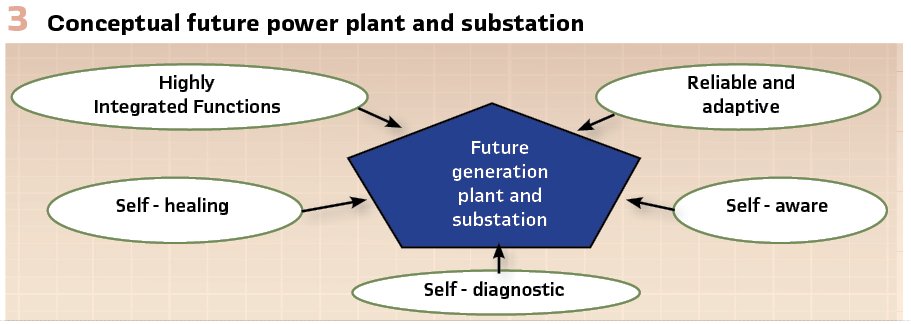
Plant and substation monitoring, and operation will be different from what we know today, namely:
- They will assume autonomy, using awareness to continuously adapt to their environment and not depend totally on a centralized control center
- They will transfer essential and critical data to the centralized control center
- The future centralized control center will have a view of the entire power plant and substation parks and perform park operating functions in addition to contributing to the grid stability
End-to-end Energy System: Profound changes in electricity demand are expected due to the sustained development of decentralized energy production and energy efficiency measures. This better market penetration is also enabled by a change in attitude on consumers, by lower technological costs and by a slight increase in electricity prices.
The impact on energy demand of these current and new technologies represents a very real change and will be synonymous with major operational challenges, increased technical tension on the network and opening of the market to new competitors in energy products and services. This is why the end-to-end Energy System must evolve and become more intelligent, dynamic, and aware of its environment to allow the circulation of electricity in both directions and accommodate consumers which can both consume and produce. (Figure 2).
The move to a high proportion of DERs will represent a complete overhaul of electricity systems and network, requiring overall thinking to globally optimize investments in distribution, transmission, and generation. Network operation will require optimization considering the entire system rather than a Top-Down approach and taking advantage of the flexibility services that can be provided by the users themselves.
Ultimately, end-to-end Energy System operation adapts dynamically to all forms of change and possible business opportunities because the real states of components/systems are mastered, making it possible to analyze, predict and make decisions about their behavior, maintain desired stability, and continuously optimize configurations and setting parameters.
Predictive maintenance is added because states of components/systems and contexts in which they operate are available in real-time and archived. In addition, collection of states generates rich histories, allowing for a panoply of probabilistic calculations that enrich the maintenance predictability which then becomes targeted, right-time-and-place and specific to real situations.
Managing those previous paradigms: the Hows
The network will undergo rapid and fundamental changes affecting its architecture, procedures, and organization. These changes will include a significant increase in the number of physical variables that must be measured and monitored and that will consequently drive different operations (unpredictable self-generation, distributed power sources, etc.).
These changes also make it necessary to incorporate the concept of dynamism into grid operation and into components/systems, instead of the traditional way, as static and predictable based on historical records. So, how to face those new paradigms?
Implementation of component/system behavior in our standards: It is becoming essential that we can integrate, within the IEC 61850/CIM standards, the behavior of components/systems in power plant and substation developed by other TCs. All future situational awareness algorithms and those for prediction (PHM, conditional-based monitoring) will be populated by those data.
Implementation of component/system health in our standards: It is becoming essential that we can integrate, within the IEC 61850/CIM standards, the status of components/systems in power plants and substations, throughout their entire life cycle. Future RAMS studies will be populated by those data. (Figure 3).
Continuous mapping of BUC/use cases: The trends, challenges and issues we are currently facing and those to come require to constantly study them, analyze them, and produce new BUC/use cases. Of course, very close coordination must also be maintained with SyC SE to ensure that BUC/use cases developed by other TCs and likely to impact TC57 are considered.
Canonical/harmonization of data models and quality/availability of data: Harmonization of data models and data quality/availability are the heart of the end-to-end Energy System success. No algorithm, no technology will be able to compensate for these inconsistencies and on the contrary, they will only contribute to the garbage in, garbage out aspect.
Situational Awareness: Figure 4 is a conceptional illustration of future power plant and substation. They are self-adaptive, highly integrated in real-time and boasts facilitator skills. In other words, they are situationally aware.
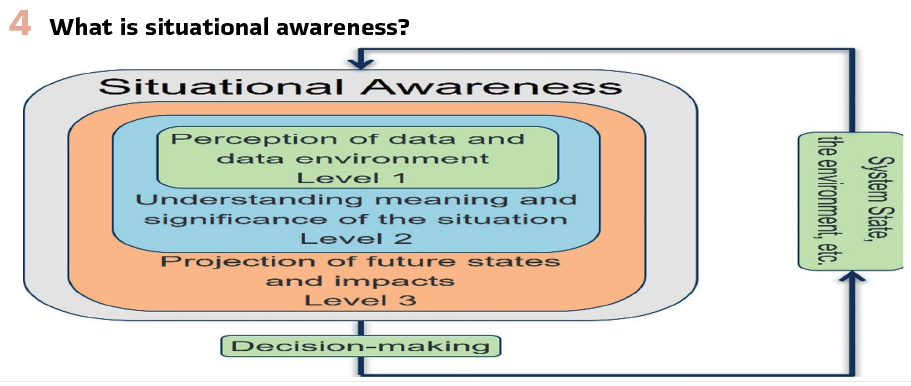
Situational awareness is defined:
- Perceiving environmental events as they affect components/systems and their relationship to time.
- Comprehending their meaning
- Projecting their status after a variable has changed
- Making decisions based on the above.
Situational awareness answers the following questions to clearly identify the real-time behavior of component/system:
- What is happening?
- Why is it happening?
- What will happen in the immediate future?
- What should I do to fix it?
Based on Figure 4, operation of power plant and substation becomes flexible, predictive, prescriptive, adaptive, and autonomous with respect to its environment and its variability (including cybersecurity). The environment can produce different event types (ms, seconds, minutes, hours, days, etc.).
Situational awareness is essential due to the growing complexity of component/system. It will become increasingly difficult to fully grasp the dynamics of network given the risks associated with the growing interaction of technologies.
Artificial Intelligence (AI)
From predicting EV charge times to pinpointing areas of high wildfire risk, AI is transforming our network. The grid is growing increasingly: where once a small number of power plants supplied most homes at a consistent flow, now millions of solar panels/windfarms generate variable electricity. Increasingly unpredictable weather adds to the challenge of balancing demand with supply. Grid operators are increasingly turning to artificial intelligence to manage the chaos.
AI’s ability to learn from large amounts of data and respond to complex scenarios makes it well suited to the task of keeping the grid stable.
The power grid system is often described as the most complex machine ever built. Because the grid is so vast, it is impossible for any one person to fully grasp everything happening within it at a given moment, let alone predict what will happen later.
AI will be used in power plant, substation and control center.
Digital Twin (DT) – DT are real-time virtual representations of physical grid asset. It can help utility companies to improve planning, operational efficiency, and personnel training. It also offers a way to stress-test important components/systems in preparation for a wide range of scenarios, including severe weather episodes. DT can also be used to monitor and reduce carbon emissions by design to reach environmental targets. Also, it can be used to run simulations, study performance issues, and generate possible actionable recommendations for improvements. (Figure 5).

At operational level, data collection from generators, substations, microgrids, and industrial and building loads can be combined in DT with many other data sources to inform grid operators about the overall situation. This real-time data can be integrated into GIS along with weather and smart meter data. GIS can map hurricane storm surges and using DT models to predict outages based on rainfall forecasts. At the distribution level, GIS and other simulations can map to BIM systems to predict loads in large commercial buildings, university microgrids, or other microgrids.
Digital Twin will be used in power plant, substation and control center.
Software Defined System: The essence of the SDS architecture is to well divide the network into three subsystems:
- Application Layer: provides user applications with programmatic interfaces to the network services regardless of the underlying resources
- Control Layer: provides a separate programmable facility for the control and management of the network infrastructure
- Infrastructure Layer: provides open standards-based interfaces to the basic IT resources
SDS is typically offered as a Service, e.g., SaaS, PaaS, and IaaS. One of the SDS key inspiration lies in Software Defined Network, which attempts to centralize network intelligence in one network component by disassociating the forwarding process of network packets (data plane) from the routing process (control plane).
One of the key strengths of SDS architecture is that it provides applications with the unique ability to obtain abstracted view of the entire information system. These make the system smarter by being able to analyze itself and integrate real-time information about system activity according to the application requirements. Practical implementation of SDS requires comprehensively control capability of sensing, communication, networking, and computation. (Figure 6). SDS will be used in power plant, substation and increased in control center.
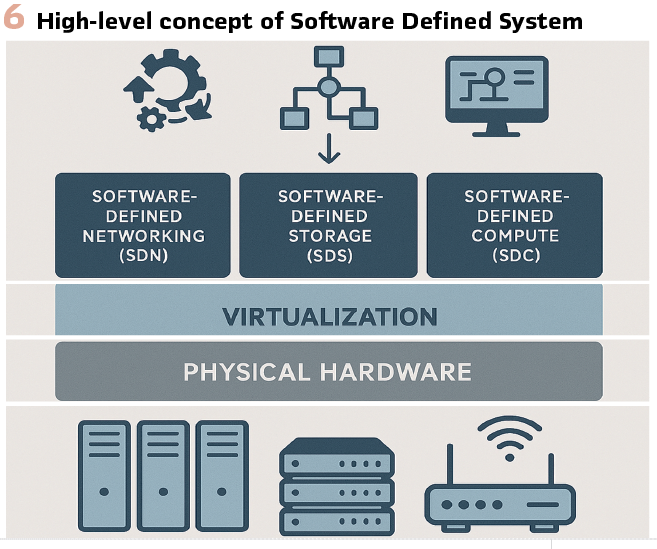
OT/IT Convergence means integrating OT technologies which work in real-time or near real-time with IT systems. Convergence doesn’t mean converting IT engineers into OT engineers and vice versa. What’s driving the convergence is the increasing complexity of networking and computing in OT and the need for a significant increase in process maturity in areas that are normally with the IT domain. The value is in material improvement in the effectiveness and capability of the cross-functional team to fulfill the core mission of secure, reliable, and streamlined operations.
Here a few of the OT challenges:
- Multiple versions of software or firmware
- Upgrading hundreds, thousands, millions of devices to new firmwar
- Adequate testing and quality assurance prior to production rollout
- Following rapid increase of networking features, capabilities and standards
- System development involving complex systems requires rigorous system engineering methods and formal life cycle development processes
- Modern control systems require significant expertise in embedded systems and security to architect, design, build, and maintain
- One of the most critical is security and cyber-attacks
- OT/IT Convergence will be used in power plant, substation and increased in control center.
Prognostic and Health Management (PHM): To enable the maintenance team to plan the right actions at the right time, the ability to detect early degradation, to identify its cause and to predict its future evolution is critical, by combining state-of-the-art DT simulation, physical models and data-driven learning models, PHM has emerged as a paradigm for monitoring, analyzing and optimizing complex systems. The aim of PHM is to provide a set of adaptive and related digital models that evolve over time to persistently represent the structure, behavior and context of a single physical asset.
Among the techniques involved in the design of PHM, AI can be used to extract relevant features from data and to learn to replicate complex tasks such as fault detection, diagnostics and prognostics. AI provides powerful tools to assimilate large amounts of data and extract relevant characteristics necessary to represent the physical asset in digital form.
PHM will be used in power plant, substation and increased in control center.
Complete life cycle of component/system: An important aspect is the complete life cycle of component/system. That’s why, all the essential data available on their complete life cycle should be provided from TC 57 standards family.
Future dream to become our reality
It’s the combination of all these deeply interconnected Hows that leads us to the realization of our dream: a detailed understanding (PHM and RAMS) of the:
1) Behavior of power plant and substation components/systems.
2) Situational awareness of power plant and substation.
3) Situational awareness of regional group of power plants and substations.
4) Situational awareness of the entire end-to-end Energy System managed by the control center. Furthermore, the control center will be able to request actions to power plant and substation based on the network status.
Biographies:

Jean Raymond, ing., Ph.D., M.Sc.A works for more than 34 years for Hydro-Québec, both as a telecom network engineer in several divisions of the company and as an engineer responsible for the evolution and the long-term development of its transmission and electricity power systems. He has developed considerable expertise in system reliability over the years. Jean holds a bachelor’s degree in electrical engineering from Université Laval, and a Master and a Ph.D. degrees in Electrical Engineering (Telecommunications) from Université Laval, in collaboration with the Defence Research Establishments. He also has more than twenty publications and a future book to be published to his credit. Jean is an active member in international working groups (IEC, IEEE), and convener of IEC TC57 AG22 “Prepare for the future”. He is a member of IEEE PES Magazine Board and reviews frequently books for Wiley&Sons. He is involved in the overhaul of Electrical Engineering and Asset Management programs in universities.



